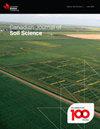土壤质地对安大略农业土壤健康评分函数的影响:一个省级土壤健康测试的可能框架
IF 1.5
4区 农林科学
Q4 SOIL SCIENCE
引用次数: 2
摘要
摘要由于土壤健康受到固有土壤特性的影响,因此,在多个地区和土壤类型中应用相同的土壤健康框架是一项挑战。在这里,我们研究了土壤质地组(粗、中、细)对安大略省不同农业系统土壤的四个土壤健康指标的影响。评分函数是通过计算三个或五个土壤质地组的累积正态分布,使用每个土壤健康指标的平均值和标准差来开发的。对于每个土壤健康指标,使用“越多越好”的方法提供土壤健康评分值,其中土壤健康评分越高意味着土壤健康越好。土壤健康指标受到三个但不是全部五个土壤质地组的显著影响。相关性和主成分分析表明,析出的NH3和CO2以及潜在的可矿化N之间具有更强的相关性。我们的结果还表明,与五个土壤质地组(粘土、粘土壤土、壤土、砂质壤土和沙子)相比,测试的土壤健康指标的平均分离度与三个土壤质地类别(粗、中、细)更一致;因此,我们建议使用三个土壤质地组来开发土壤健康评分函数。这项研究的结果为未来的土壤健康评估奠定了基础,该评估涉及安大略省的大量样本和更多的土壤指标,这将有助于对土壤健康的区域解释。本文章由计算机程序翻译,如有差异,请以英文原文为准。
Soil texture influences on soil health scoring functions in Ontario agricultural soils: a possible framework towards a provincial soil health test
Abstract Since soil health is impacted by inherent soil properties, it is, therefore, challenging to apply the same soil health frameworks across multiple regions and soil types. Here, we examined the effect of soil textural group (coarse, medium, and fine) on four soil health indicators of soils sampled from diverse agricultural systems across Ontario. Scoring functions were developed by calculating cumulative normal distributions, using the mean and standard deviation of each soil health indicator, for three or five soil textural groups. For each soil health indicator, soil health scoring values were provided using the “more is better” approach, where greater soil health scores implied better soil health. Soil health indicators were significantly affected by three but not all five soil textural groups. Evolved NH3 and CO2, and potentially mineralizable N had stronger associations with each other as revealed by correlation and principal component analysis. Our results also suggested that mean separation of the tested soil health indicators was more consistent with three soil textural groups (coarse, medium, and fine) than five soil textural groups (clays, clay loams, loams, sandy loams, and sand); therefore, we recommend using three soil textural groups to develop soil health scoring functions. The findings of this study lay a groundwork for future soil health assessment involving a larger number of samples across Ontario and more soil indicators, which will facilitate the regional interpretation of soil health.
求助全文
通过发布文献求助,成功后即可免费获取论文全文。
去求助
来源期刊

Canadian Journal of Soil Science
农林科学-土壤科学
CiteScore
2.90
自引率
11.80%
发文量
73
审稿时长
6.0 months
期刊介绍:
The Canadian Journal of Soil Science is an international peer-reviewed journal published in cooperation with the Canadian Society of Soil Science. The journal publishes original research on the use, management, structure and development of soils and draws from the disciplines of soil science, agrometeorology, ecology, agricultural engineering, environmental science, hydrology, forestry, geology, geography and climatology. Research is published in a number of topic sections including: agrometeorology; ecology, biological processes and plant interactions; composition and chemical processes; physical processes and interfaces; genesis, landscape processes and relationships; contamination and environmental stewardship; and management for agricultural, forestry and urban uses.
 求助内容:
求助内容: 应助结果提醒方式:
应助结果提醒方式:


